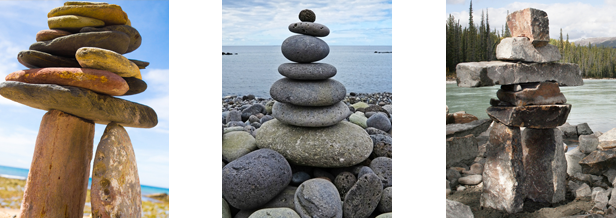Originating from the old Scottish Gaelic word “cairn” (meaning literally “heap of stones”), the cairn is one of the oldest symbolic and aesthetic structures created by humans. Cairns are found everywhere: atop mountains and hills, alongside rivers, and in the midst of forests, jungles, plains and deserts all over the world. Today, the cairn is most commonly used as a trail marker: an indication to a traveler that he or she is on the right path. But the cairn has its roots in all sorts of symbolic uses. Cairns have been used as monuments honoring those who have passed, as structures to mark the site of a place holding particular spiritual or ceremonial significance, or as collaborative art pieces wherein the stack of stones is built/maintained by a number of individuals.
In Africa, cairns are a common feature, and can be found in what remains of some of the earliest human settlements. In many parts of Asia, cairns dot mountain paths not only as trail markers, but also as a sign of reverence to San-shin, the Mountain Spirit, and to bring good luck to those who add a stone. Cairns feature symbolically in a number of Buddhist ceremonies, and there remains an old Jewish tradition of placing small stones on a person’s grave as a sign of respect. In the Italian Alps, cairns dot the trails and summits, and are called by the Italian word ometto, or “small man”, a reference to the stone stack’s function as a guide.
Although it is a simple and unpretentious structure, the cairn seems to communicate an innate sense of benevolence and significance to the human spirit. A sort of ancient and friendly salute from one person to another; a tribute to our shared experiences as travelers through this life. In Scotland, there is a casual tradition of taking a stone from the bottom to the top when climbing a hill, because more often than not, there will be a cairn at the summit upon which you can place it. In fact, there exists an old Scottish blessing: Cuiridh mi clach air do chàrn, meaning "I'll put a stone on your cairn". Kind, simple, and honorable, this blessing expresses reverence for the work of others, and a pledge to assist one’s fellow humans in their endeavors. A guide, a monument, and a sign of solidarity; the cairn is a symbol of some of the most noble and enduring aspects of humanity, and it is this philosophy that we strive to preserve in our practice of helping you plan for your legacy.
